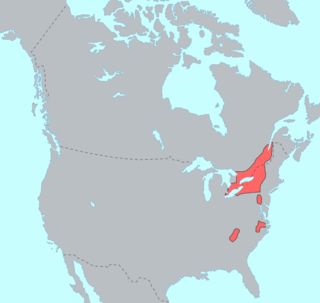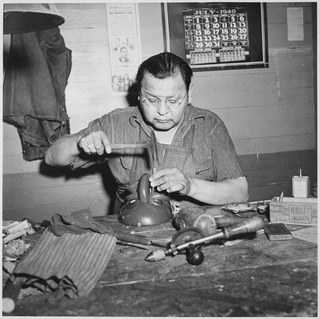
The Tuscarora are an Indigenous Peoples of the Northeastern Woodlands in Canada and the United States. They are an Iroquoian Native American and First Nations people. The Tuscarora Nation, a federally recognized tribe, is based in New York, and the Tuscarora First Nation is one of the Six Nations of the Grand River in Ontario.

Hiawatha, also known as Ayenwatha or Aiionwatha, was a precolonial Native American leader and cofounder of the Iroquois Confederacy. He was a leader of the Onondaga people, the Mohawk people, or both. According to some accounts, he was born an Onondaga but adopted into the Mohawks.

Among the Haudenosaunee the Great Law of Peace, also known as Gayanashagowa, is the oral constitution of the Iroquois Confederacy. The law was represented by symbols on wampum belts which functioned as mnemonic devices for storytellers, conceived by Dekanawidah, known as the Great Peacemaker, and his spokesman Hiawatha. The original five member nations ratified this constitution near modern-day Victor, New York, with the sixth nation being added in 1722.

Gerald Robert Vizenor is an American writer and scholar, and an enrolled member of the Minnesota Chippewa Tribe, White Earth Reservation. Vizenor also taught for many years at the University of California, Berkeley, where he was Director of Native American Studies. With more than 30 books published, Vizenor is Professor Emeritus at the University of California, Berkeley, and Professor of American Studies at the University of New Mexico.

The Beaver Wars, also known as the Iroquois Wars or the French and Iroquois Wars, were a series of conflicts fought intermittently during the 17th century in North America throughout the Saint Lawrence River valley in Canada and the Great Lakes region which pitted the Iroquois against the Hurons, northern Algonquians and their French allies. As a result of this conflict, the Iroquois destroyed several confederacies and tribes through warfare: the Hurons or Wendat, Erie, Neutral, Wenro, Petun, Susquehannock, Mohican and northern Algonquins whom they defeated and dispersed, some fleeing to neighbouring peoples and others assimilated, routed, or killed.
The Seneca are a group of Indigenous Iroquoian-speaking people who historically lived south of Lake Ontario, one of the five Great Lakes in North America. Their nation was the farthest to the west within the Six Nations or Iroquois League (Haudenosaunee) in New York before the American Revolution. For this reason, they are called “The Keepers of the Western Door.”

The Onondaga people are one of the five original nations of the Haudenosaunee (Iroquois) Confederacy in the Northeastern Woodlands. Their historical homelands are in and around present-day Onondaga County, New York, south of Lake Ontario.

Six Nations is demographically the largest First Nations reserve in Canada. As of the end of 2017, it has a total of 27,276 members, 12,848 of whom live on the reserve. These nations are the Mohawk, Cayuga, Onondaga, Oneida, Seneca and Tuscarora. Some Lenape live in the territory as well.

The Iroquoian languages are a language family of indigenous peoples of North America. They are known for their general lack of labial consonants. The Iroquoian languages are polysynthetic and head-marking.
Oren R. Lyons Jr. is a Haudenosaunee Faithkeeper of the Wolf Clan of both the Onondaga Nation and the Seneca Nation of the Six Nations of the Grand River. For more than 14 years he has been a member of the Indigenous Peoples of the Human Rights Commission of the United Nations and has had other leadership roles.

Jesse J. Cornplanter was an actor, artist, author, craftsman, Seneca Faithkeeper and decorated veteran of World War I. The last male descendant of Cornplanter, an important 18th-century Haudenosaunee leader and war chief, his Seneca name was Hayonhwonhish. He illustrated several books about Seneca and Iroquois life. Jesse Cornplanter wrote and illustrated Legends of the Longhouse (1938), which records many Iroquois traditional stories. Cornplanter was also the first Native American to play a lead in a feature film titled Hiawatha, which was released in 1913 and a year before the notable Western The Squaw Man.

The Iroquois, also known as the Five Nations, and later as the Six Nations from 1722 onwards; alternatively referred to by the endonym Haudenosaunee are an Iroquoian-speaking confederacy of Native Americans and First Nations peoples in northeast North America. They were known by the French during the colonial years as the Iroquois League, and later as the Iroquois Confederacy, while the English simply called them the "Five Nations". The peoples of the Iroquois included the Mohawk, Oneida, Onondaga, Cayuga, and Seneca. After 1722, the Iroquoian-speaking Tuscarora people from the southeast were accepted into the confederacy, from which point it was known as the "Six Nations".

Tadodaho was a Native American Hoyenah (sachem) of the Onondaga nation before the Deganawidah and Hiawatha formed the Iroquois League, or "Haudenosaunee". According to oral tradition, he had extraordinary characteristics and was widely feared, but he was persuaded to support the confederacy of the Five Nations.

Bearheart: The Heirship Chronicles is a 1990 novel by Gerald Vizenor; it is a revised version of his 1978 debut novel Darkness in Saint Louis: Bearheart. The novel is a part of the Native American Renaissance and is considered one of the first Native American novels to introduce a trickster figure into a contemporary setting. Vizenor drew from trickster traditions from various Native American tribes, such as Nanabozho (Anishinaabe) and Kachina (Pueblo).

Native American rhetoric is the rhetoric used by Indigenous peoples for purposes of self-determination and self-naming, in academia and a variety of media.
Jolene Rickard, born 1956, citizen of the Tuscarora Nation, Turtle clan, is an artist, curator, and visual historian at Cornell University, specializing in Indigenous peoples issues. Rickard co-curated two of the four permanent exhibitions for the Smithsonian’s National Museum of the American Indian.

Sketches of the Ancient History of the Six Nations, by the Tuscarora David Cusick, is a mytho-historical narrative about the Iroquois Confederacy of six tribes: the Mohawk, Oneida, Onondaga, Cayuga, Seneca and, later, the Tuscarora. First published between 1826 and 1827, the work has three parts: "A Tale of the Foundation of the Great Island ;" "A Real Account of the Settlement of North America and their Dissentions", and "Origin of the Kingdom of the Five Nations." It was among the earliest English-language attempts to record Native American history from a Native American perspective.
Simeon Gibson was a member of the Cayuga tribe and the Onondaga Longhouse on the Six Nations Reserve. Gibson (Iroquois) worked closely with Iroquois researchers, including Horatio Hale, David Boyle, Mark Raymond Harrington, A.C. Parker, and John Napoleon Brinton (J.N.B.) Hewitt. Gibson worked with these researchers to interpret his father Chief Gibson’s two records of the Daganawi:dah legend.
The Everett Report of 1922 was a New York State Assembly report compiled by a legislative commission led by Edward A. Everett. It concluded that "the Iroquois were fraudulently dispossessed of over six million acres of land in New York." However, the report was "buried" by New York State and not published until 1971.

Apple (Skin to the Core) is a poetic memoir for young adults, written by Eric Gansworth and published October 6, 2020 by Levine Querido. In this book, Gansworth talks about his life as an Onondaga individual, living amongst Tuscaroras, and the impact of residential schooling. As he covers these topics, he discusses common slurs against Indigenous Americans, including the term "apple," which refers to someone who is "red on the outside, white on the inside," that is, who looks Indigenous but acts white.













